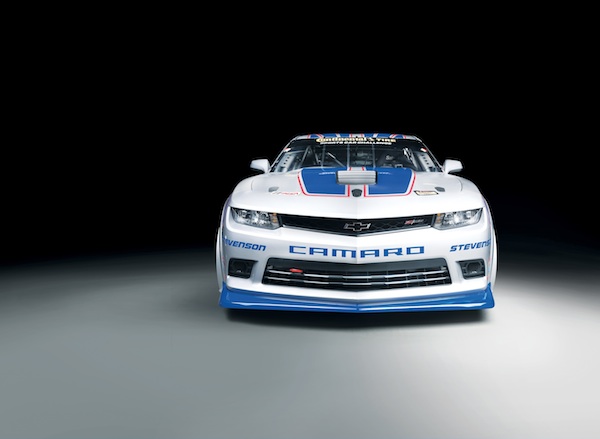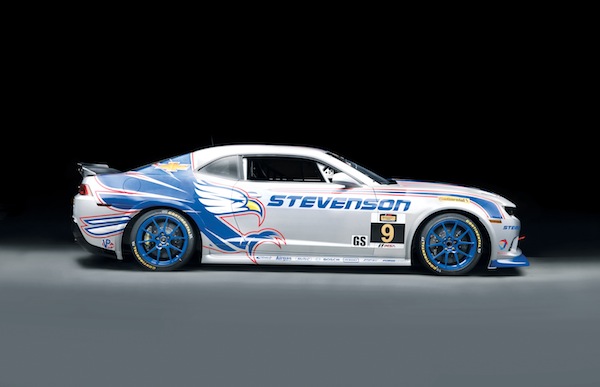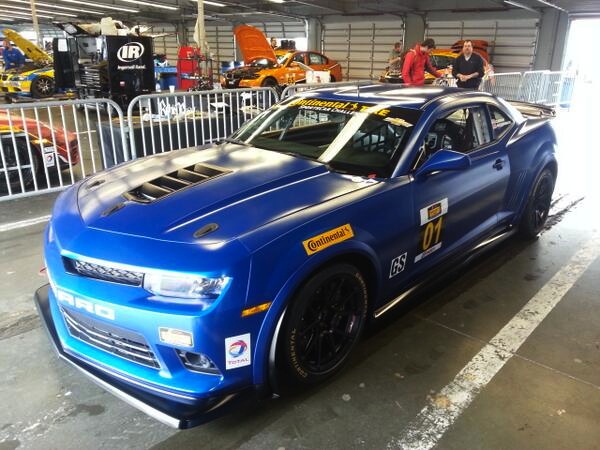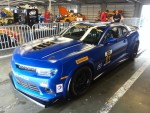The Camaro Z/28’s Big Brother: The Z/28.R

Camaro chief engineer Al Oppenheiser said the factory Z/28 was built to be, “…the fastest road-racing Camaro possible that was still street-legal,” according to a GM press release. It comes to no surprise than that the Z/28.R has few variations from the production model. Both are equipped with a dry-sump LS7, Tremec TR6060 six-speed, and helical-gear, limited-slip differential. Outside, the Z/28.R shares aerodynamics, including the front splitter, rear spoiler, hood extractor vent, rockers, wheelhouse extensions, front tire deflectors, and belly pan with its production brother.
The Z/28.R competed in its first race at the inaugural Continental Tire SportsCar Challenge BMW Performance 200 at Daytona. The Continental Tire SportsCar Challenge is a new series that came from the IMSA merger of the American Le Mans Series and Rolex Sports Car series (now known as TUDOR United Sportscar Championship). The Continental Tire Sports Car Challenge features the GS series and GT series that race door to door with each other. It’s typically an opening act for TUDOR racing (if you’re into NASCAR look at the Continental series as the Camping World Truck Series, a division that normally races a day or two before the main event).
Three Camaros made it to the green flag of the first race of the season in the GS series, two from Stevenson Motorsports and one from CKS Autosport. Chevrolet’s new cars entered the TUDOR racing world with less than desirable finishes. Both Corvettes had gearbox issues at the 24 Hours of Daytona, one with a DNF. In the Continental Tire SportsCar Challenge, Stevenson Motorsports No.09 Z/28.R had fuel line issues finishing out 23rd and the No. 06 had a DNF from a differential failure. The CKS Autosport’s No. 01 fared better with an 11th place finish. There was a lot of talk about “collecting data, and learning a lot,” which read like excuses–but turned out to be true because the next race the Z/28.R saw victory lane. At only the car’s second outing, the No. 6 driven by Robin Linddell and Andrew Davis won at Sebring International Raceway.

What about the drivetrain? It’s a race car so a ton has to be better than stock right? Wrong. The only major difference for the LS7 is an aftermarket oiling system. Underneath the road version features double-ball-joint, multi-link strut with an inverted mono-tube shock absorber, and a 4.5-link independent with sway bar out back. For the race version, it’s pretty much the same minus some beefier bushings and struts. All of the suspension points are factory and most of the pieces, even the control arms, are stock. Famed GM race car builders, Pratt & Miller Engineering, who built most of the C7.R, also helped build the Z/28.Rs—but that was mostly fabricating a roll cage.
The introduction of the C7 Corvette Z06 earlier this year was accompanied by the C7.R, Chevrolet’s big boy race car. It finally allows Chevrolet to use its direct-injection technology (as the Corvette had not offered it until the LT1) and showcase the C7 on the track. The C7.R was introduced at the 2014 North American International Auto Show Detroit alongside the race version of the long-anticipated Z/28, the Z/28.R. The C7.R with its huge mouth-shaped grille, aero work, and raised wing, resembles nothing of its dealership-showroom-counterpart. The Z/28.R on the other hand, features identical parts with the factory Z/28, using most of the factory drivetrain and wrapped in a basically stock body.
“Apart from series-mandated equipment and the specialized suspension components needed for endurance racing, the Z/28.R is as close to a production-spec race car as you’ll find,” said Mark Kent, director of racing for Chevrolet, as according to a GM press release.
The road version features gigantic Brembo carbon-ceramic discs, 15.5- by 1.4-inch up front and 15.3- by 1.3-inch out back. They cut down on unsprung weight and brought the Camaro to an eyeball-out-of-your-socket deceleration force of 1.5 g, according to Chevrolet. IMSA rules require iron rotors, however, so the brakes had to go.
Even if you don’t find this wine-and-cheese style racing exciting, it’s noteworthy that Chevrolet built such a monster of a car that they basically put in a roll cage, tires, bushings, and shocks and go endurance racing.
What do you think about the Z/28.R? Is it just another decaled race car or something we can learn from? Comment below.
- CKS Autosport at Laguna Seca. Photo courtesy of CKS Autorsport.
- CKS Autosport at Laguna Seca. Photo courtesy of CKS Autorsport.






